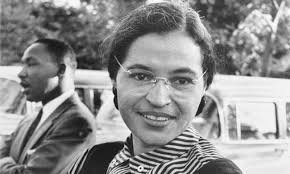Rosa Parks is Early Life and Activism in the Segregated South
Rosa Parks was born on February 4, 1913, in Tuskegee, Alabama, into a world of racial segregation and Jim Crow laws. Her childhood was marked by the constant threat of racial violence, including the frequent presence of the Ku Klux Klan near her home. Few know that Rosa’s grandfather, Sylvester Edwards, kept a shotgun by the door to protect their family, instilling in her an early awareness of resistance. Her mother, a teacher, homeschooled Rosa until age 11, emphasizing the value of education despite systemic barriers.
By her teenage years, Rosa attended the Montgomery Industrial School for Girls, where she was taught Black history and self-respect—a radical concept in the 1920s South. In 1932, she married Raymond Parks, a barber and NAACP member who deepened her involvement in civil rights. A lesser-known fact is that Rosa spent years documenting cases of racial violence and voter suppression as the NAACP’s secretary, long before her famous bus protest.
The Montgomery Bus Boycott That Changed History
On December 1, 1955, Rosa Parks refused to surrender her seat to a white passenger on a Montgomery bus, sparking the 381-day Montgomery Bus Boycott. While often portrayed as a spontaneous act of exhaustion, her defiance was deliberate—she had attended workshops at Tennessee’s Highlander Folk School, a hub for civil rights strategy. The boycott, led by a young Dr. Martin Luther King Jr., crippled the city’s transit system and became a turning point in the fight against segregation.
Few know that Rosa wasn’t the first Black woman arrested for this act—15-year-old Claudette Colvin had done so nine months earlier. But the NAACP chose Rosa as their symbol because of her impeccable reputation and calm demeanor. After her arrest, she lost her job at a department store and faced relentless death threats, yet never wavered.
Exile in Detroit and Continued Activism
Forced to leave Montgomery due to economic retaliation and harassment, Rosa and Raymond moved to Detroit in 1957. There, she worked with Congressman John Conyers for over 20 years while aiding homeless families and protesting housing discrimination. A little-known story involves her 1965 march alongside Dr. King in Selma—where she later helped organize the Freedom Now Party to combat police brutality in Northern cities.
Despite her iconic status, Rosa struggled financially for years, at one point working as a seamstress to make ends meet. She quietly paid for young activists’ bail and scholarships, embodying her belief that “the struggle continues.”
Rosa Parks Fighting for Justice Beyond the Bus
While the bus protest defined her legacy, Rosa’s activism spanned decades. In the 1970s, she campaigned for reparations for Black victims of medical experiments like the Tuskegee Syphilis Study. She also co-founded the Rosa and Raymond Parks Institute for Self-Development to mentor youth.
A surprising fact? In 1994, at 81, she was robbed and assaulted in her Detroit home. The attacker, Joseph Skipper, claimed he didn’t recognize her—a stark reminder that her sacrifices weren’t universally honored in her lifetime.

Awards, Honors, and Late-Life Advocacy of Rosa Parks
Rosa received the Presidential Medal of Freedom (1996) and Congressional Gold Medal (1999), yet remained humble. In her 80s, she still attended protests against South African apartheid and spoke out about racial profiling.
One poignant moment came in 2002 when she met Pope John Paul II, who praised her as a “living icon of human dignity.” Privately, she confided that her greatest pride was seeing young activists continue her work.
The Highlander Folk School: Where Resistance Was Nurtured
Long before her famed bus protest, Rosa Parks attended workshops at the Highlander Folk School in Tennessee—a secretive hub for civil rights training that Southern whites called “Communist.” Here, she learned tactics of nonviolent resistance alongside activists like Septima Clark, who taught literacy classes to empower Black voters. Few know that Rosa initially hesitated to attend, fearing retaliation, but left transformed, later calling Highlander “the first time in my life I was treated as a full human being.” This experience directly inspired her bus defiance, proving her act wasn’t spontaneous but strategically cultivated. The school’s influence was so threatening that Tennessee officials raided and shut it down in 1961, but its legacy lived on through Rosa’s courage.
Rosa Parks No One Knows: Financial Struggles and Forgotten Battles
Behind her iconic image, Rosa faced decades of hardship. After the boycott, she was blacklisted from Montgomery jobs and received no royalties from most documentaries about her life. In Detroit, she and Raymond survived on meager wages, at one point donating blood for extra cash. A shocking 1994 incident saw her robbed in her own home by a young Black man—a painful irony she met with grace, later advocating for his education in prison. Even in her 80s, she quietly paid legal fees for wrongfully jailed Black youth, telling friends, “I’m not a symbol, I’m an activist.” These untold stories reveal a woman who sacrificed far more than a bus seat—her lifelong fight extended to economic justice, prison reform, and intergenerational mentorship.
Death and Unwavering Legacy of Rosa Parks
Rosa Parks died on October 24, 2005, at 92. She became the first woman to lie in honor at the U.S. Capitol, where 50,000 paid respects. Today, her Detroit home—threatened with demolition in 2016—was rescued by artists and moved to Berlin, then displayed in Naples as a global symbol of resistance.
Her quiet strength endures in movements like Black Lives Matter. As she once said: “Stand for something, or you’ll fall for anything.”
Go to main page


